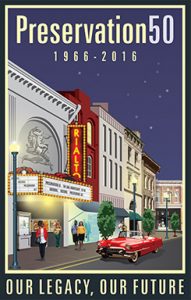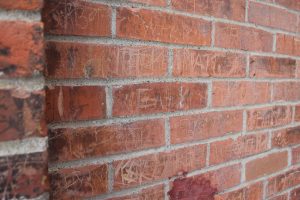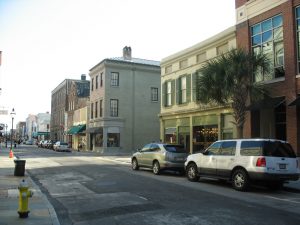One word has been infiltrating my lexicon in a major way over the last five years:
iterative
Simply put, iterative means repetitive. However, while repetitive suggests doing the same thing over and over, iterative implies using slightly modified methods as a means to refine process and improve results. As we near the 50th anniversary of the National Historic Preservation Act, I have been reflecting on the iterative nature of historic preservation.
 In its broadest sense, historic preservation is about preserving cultural heritage: things and traditions passed down to us from previous generations. In the United States, the term is used primarily in reference to the built environment but also refers to archaeological sites, cultural landscapes, and other types of historic properties.
In its broadest sense, historic preservation is about preserving cultural heritage: things and traditions passed down to us from previous generations. In the United States, the term is used primarily in reference to the built environment but also refers to archaeological sites, cultural landscapes, and other types of historic properties.
During my twenty-plus years in this field, I have heard many criticisms of the staid nature of preservation. More than just “historic preservation standing in the way of progress,” there is criticism about the lack of evolution in the field. For example, preservation tends to focus on tangible heritage (objects and places) instead of—and sometimes to the detriment to—intangible heritage (the practices, knowledge, and skills we inherit from previous generations). There is also a lack of diversity in historic preservation, reflected in both preservation professionals and the historic properties we advocate for preservation.
However, I have found that historic preservation—both in practice and in policy—is iterative. And, in order for it to continue to have an impact in building better communities, historic preservation must continue to evolve.
historic preservation practice
The technical practice of historic preservation—the conservation of bricks and mortar, if you will—has changed dramatically over the last fifty years. Not only have specific preservation treatments changed as technology improves, but the way we approach preservation of historic sites as a whole has evolved.

Our approach to preservation practice at historic sites has similarly evolved through iteration. Minnesota’s Historic Fort Snelling (image at the top of this post) was built in the early 1800s at the confluence of the Minnesota and Mississippi Rivers, a sacred location for American Indians. The fort served the US military for well over a century but was eventually decommissioned. Beginning in the 1960s, the Minnesota Historical Society (MNHS) began to restore the fort to its 1827 appearance, demolishing buildings and additions built after the targeted restoration & interpretation period and reconstructing buildings lost to time.* Additional destructive “restoration” was contemplated well into the 1990s. Lost in the restoration effort was the developmental history of not only the fort but of past efforts to preserve and interpret it. Ignored in the interpretive effort was centuries of American Indian history related to Bdote, African American history related to Dred and Harriet Scott (and others), and Japanese American history related to the Military Intelligence Service Language School. Today, however, MNHS is creating a new vision for Historic Fort Snelling, promising inclusion of histories previously hidden from view and acknowledging historic resources other than those related to 1827. Through iteration, the MNHS interpretation and preservation of the property has a chance to evolve beyond the history of colonialism represented by the fort itself.
historic preservation policy

U.S. historic preservation policy has also been iterative. Other than some federal efforts related to parklands beginning in the late 1800s and a few municipal efforts to create preservation ordinances beginning in the 1930s, preservation before 1966 was mostly privately funded and initiated. The federal historic preservation program as we know it today was created in 1966 with the passage of the National Historic Preservation Act (54 USC 300101 et seq.). In addition to creating the National Register of Historic Places, the Act inspired the concept of a national historic preservation partnership through the creation of State Historic Preservation Offices, and it created a review process requiring federal agencies to consider historic properties as part of project planning (commonly known as Section 106).
But what was written in 1966 has evolved in response to changing needs. Amendments to the Act in 1976 expanded the definition of historic property for the purposes of Section 106 to include properties eligible for listing in the National Register of Historic Places, not just those already listed in the National Register. And, through amendments to the Act in 1980 and 1992, the national historic preservation partnership was expanded to formalize the roles of local and tribal governments, respectively. Having those critical voices shaping and participating in the federal preservation programs was an extremely important improvement, codified through iteration.
historic preservation must remain iterative
So, is historic preservation staid? Not exactly. Does it evolve at a snail’s pace? Of course it does; anything that has passion and policy behind it evolves slowly, especially when the passion doesn’t always align with the policy. But our preservation practices have changed. We continue to learn more about conservation and are thinking about how to approach preservation from new perspectives, rather than just the easy ones. The policies the federal government established in 1966 were written in response to specific needs coming out of urban renewal, and have been modified over time to address gaps identified through iteration. If they do not adequately address today’s needs, they too must continue to evolve.
Historic preservation in the United States has come a long way in fifty years. While now is the perfect time to reflect and identify gaps needing to be filled, those of us working in the field must also be willing to accept change through constant iteration. We cannot simply wait for the next anniversary to see what needs to be done to improve our profession. We need to be willing to make continuous improvements to the work we do in hope that it will also continually improve the communities in which we live.
Note:
*Much of the 1960s restoration efforts at Historic Fort Snelling were documented in a 1970 issue of Minnesota History, a portion of which is linked from the MNHS website for the historic site.

